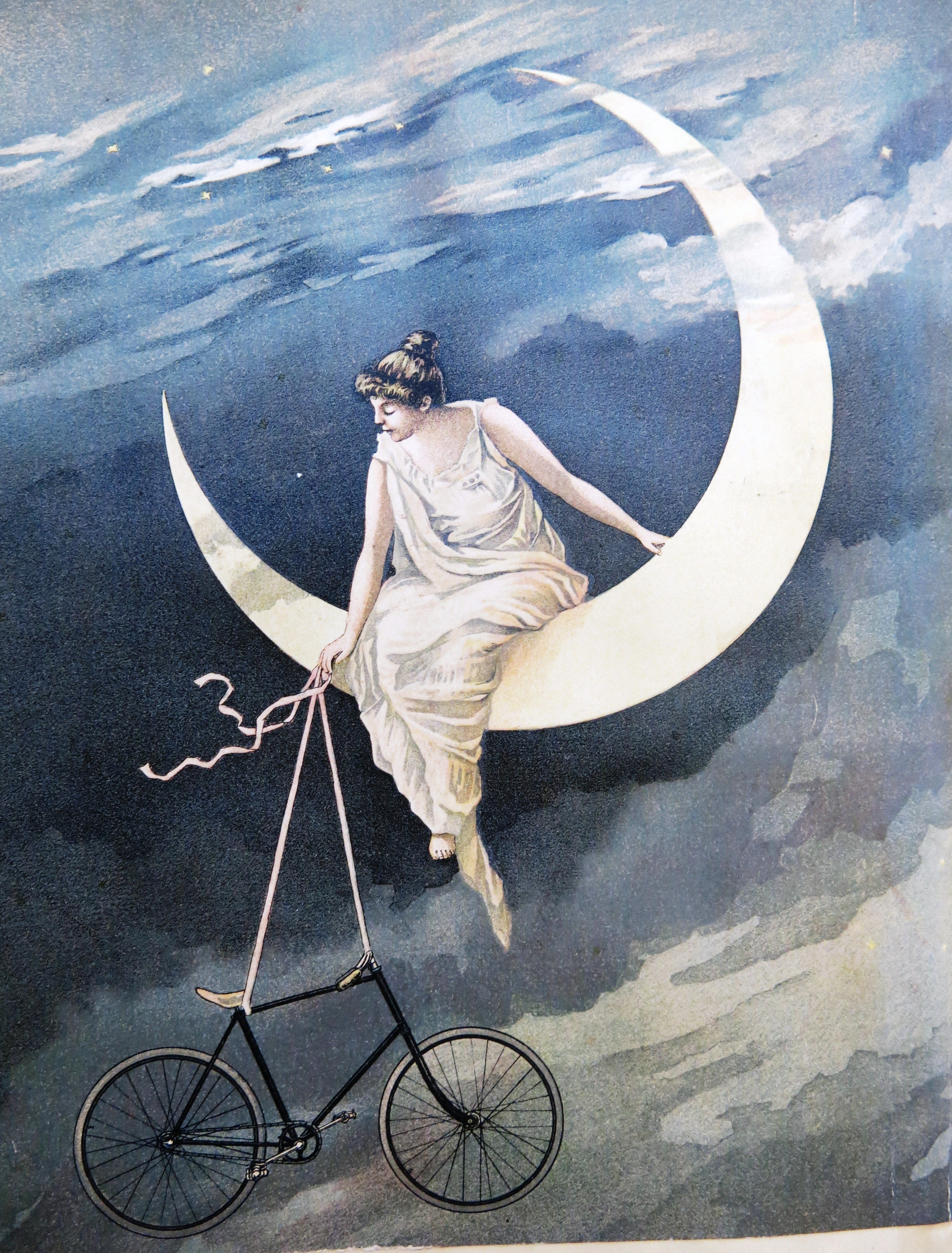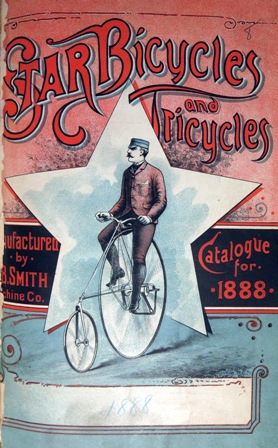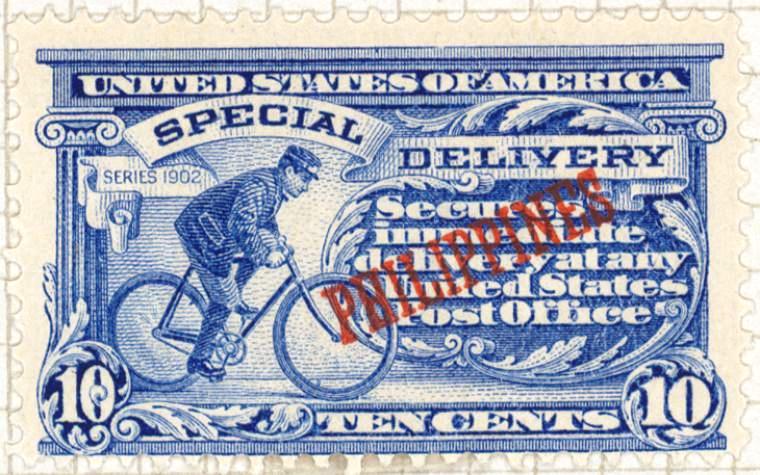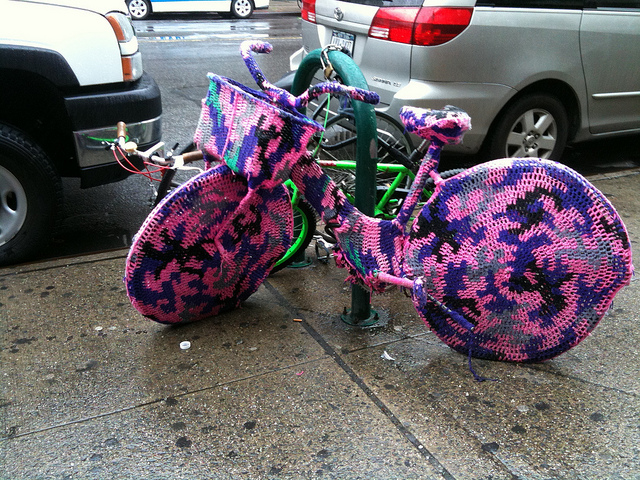Will Bicycles Save the Human Race?

Bicycles were first introduced in 19th century Europe and by now number approximately one billion worldwide, providing the principal means of transportation in many regions. In Bicycle: The History, David Herlihy noted the passions the introduction of bicycle aroused. Mark Twain (1835-1910) supposedly wrote: “Get a bicycle. You will not regret it—if you live.” On the other hand, the pioneer racer James Moore insisted the bicycle would become “as common as umbrellas.” How many umbrellas are there worldwide today? (A hint: you might want to use one of our market research databases like recently acquired Mintel Oxygen.)
Before the use of bicycles blossomed in America it was the velocipede (“fast foot”) that caused quite a sensation when it was introduced in New York in 1868. It was made of stiff materials, straight angles and steel wheels, making this bike rather rough to ride over the cobblestone roads. Thus came its nickname “Bone Shaker.” Despite its shortcomings it caused just about enough commotion in New York to be remembered as part of Velocipede Mania!

[SIBL, Call number: TOR-n.c. 21]
Later came the High Wheelers. They were more comfortable to ride than their precursor, but they required an acrobat to mount so their attractiveness was limited. The price was yet another obstacle. Columbia Bicycles sold the 60" High Wheelers for whopping $125.00. It’s not a surprise that they became popular mostly among well-to-do young men.
Accompanying the interest in bicycles in the second half of the 19th century was the publication of numerous “how-to” guides, of which several are present in the New York Public Library’s collection.
- Velox, Velocipedes, Bicycles, and Tricycles: How to Make and How to Use Them. With a Sketch of Their History, Invention, and Progress (London-New York: G. Routledge and sons, 1869),
- Charles E. Pratt, The American Bicycler: A Manual for the Observer, the Learner, and the Expert (Boston: Houghton, Osgood and Company, 1879),
- S. DeVere Burr, Bicycle Repairing; a Manual Compiled from Articles in The Iron Age (New York: Williams, 1896),
- Archibald Sharp, Bicycles & Tricycles; an Elementary Treatise on Their Design and Construction, with Examples and Tables (London-New York: Longmans, Green, 1896),
- Carlo Bourlet, La bicyclette, sa construction et sa forme (Paris, Gauthier-Villars,1899).


Bicycling soon became one more advance in the process of achieving women’s rights and liberation. As early as 1888, advertisements show models of “bicycle-gowns.” Harry Hewitt Griffin was on top of things in 1890 when he published Cycles and Cycling (New York: Frederick A. Stokes Co.) which was also issued three years later in its 2nd revised edition (London, G. Bell & Sons).
Both editions included “A Chapter for Ladies” written by Miss L.C. Davidson who among other things stated:
“It is almost impossible for those women who have taken up cycling within the last year or two to realize the amount of general suspicion and prejudice from people who looked no further than the surface, which had to be encountered and lived down by the first women who ventured a-wheel. It is thanks to their courage and good sense that their sisters are able to participate without remonstrance in delights which would otherwise never have been theirs. (…)”

The ever-growing delight of bicycle riding at the end of the 19th century is reflected in a unique item in the New York Public Library’s collection. A Scrapbook Containing Advertising Leaflets, Catalogue Descriptions, Newspaper Articles and Manuscript Notes Relating to Bicycles and Bicycling may have been compiled in East Orange, New Jersey around 1896 and was later donated to the library. Each of the two volumes is of a large size (15x10 inches) and consists of some 180 pages filled with article clippings as well as maps, plans, logos, and portraits. Some illustrations are in color. Unfortunately the original sources of the clippings are rarely provided.
The NYPL also possess some old bicycle trade catalogs (stored at SIBL). Once not believed to be of permanent value they are quite valuable today in several different ways. Lawrence B. Romaine in his A Guide to American Trade Catalogs, 1744-1900 stated that “American bicycle catalogs are among the most colorful examples ever produced, and stand second only to the carriage catalogs of the Gay Nineties, and the automobile catalogs of the 20th century. The manufacturers employed many of the finest lithographers, and their copy writers were tops.”

[SIBL, call no. TOR-n.c. 21]

[SIBL, call no. TOR n.c. 32]

With substantial manufacturing output and sales, the bicycle industry was born and soon analyzed and discussed in various publications. In 1889, Harry Hewitt Griffin published Bicycles and Tricycles of the Year 1889; Being a Chronicle of the New Inventions and Improvements Introduced This Year in the Manufacture of Bicycles and Tricycles ... Written From Personal Examination.
In the 1900, US Census data on the bicycle industry was collected and it was published 2 years later in Manufactures: Bicycles and Tricycles. It included data on industry establishments, finances, and operations, with detail by selected state; for cycles as by-products of other industries, and automobiles produced in cycle factories; trade; and patents issued.

The production of inexpensive cars (Ford Model T anybody?) changed the world of transportation, but not all was lost for the bike. American journalist writer and poet Christopher Morley (1890-1957) saw an ever-lasting place for bicycles. In his Parnassus on Wheels (1919) he wrote “The bicycle, the bicycle surely, should always be the vehicle of novelists and poets.” In 1921 W.F. Grew published The Cycle Industry, Its Origin, History and Latest Developments. The bike was also to play a political role. A Chilean politician in Allende's government, Jose Antonio Viera Gall (b. 1943) declared much later that “Socialism can only arrive by bicycle.” Thus the idea of bicycling has persisted in one form of another.
As a matter of fact, we have witnessed growing interest in bicycling worldwide (including New York City) for quite some time. In 2012 the Italian national newspaper La Repubblica reported that in Italy in 2011 bike sales surpassed car sales for the first time since World War II! According to industry report in IBISWorld database (available at SIBL) bicycle riding participation increased in the United States to 39.1 million in 2011. Unfortunately, at the same time the bicycle manufacturing industry which used to be roughly a billion-dollar sector in 2003, posted much reduced revenue of $872.2 million in 2013. Problems with its growth existed even before the recession which caused further steep declines in industry revenue. Inexpensive imports have also been challenging the industry, and domestic producers have responded by closing facilities or relocating them abroad. The number of domestic US bicycle manufacturers is believed to be reduced to 44 (2013).
Although domestic production of bicycles has dwindled the overall bicycle, related parts and accessories sales have been steadily growing to reach $6.1 billion in 2012 according to The National Bicycle Dealers Association. In addition, an estimated $1.1 billion in used bicycles was sold that year (private party sales are not included here).
An American entrepreneur and inventor Dean Kamen once said that “The city needs a car like a fish needs a bicycle.” Still, despite widespread interest in bicycling it is the car that is the primary mode of urban transportation worldwide. Elly Blue in her recent book Bikenomics: How Bicycling Can Save the Economy calls for adopting more sustainable modes of transportation and discusses the economic benefits of bicycling. Herbert George Wells saw even bigger role for bicycles. He apparently once said: “Every time I see an adult on a bicycle, I no longer despair for the future of the human race.”
Read E-Books with SimplyE
 With your library card, it's easier than ever to choose from more than 300,000 e-books on SimplyE, The New York Public Library's free e-reader app. Gain access to digital resources for all ages, including e-books, audiobooks, databases, and more.
With your library card, it's easier than ever to choose from more than 300,000 e-books on SimplyE, The New York Public Library's free e-reader app. Gain access to digital resources for all ages, including e-books, audiobooks, databases, and more.
If you don’t have an NYPL library card, New York State residents can apply for a digital card online or through SimplyE (available on the App Store or Google Play).
Need more help? Read our guide to using SimplyE.


